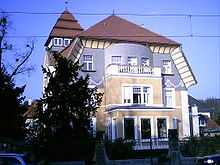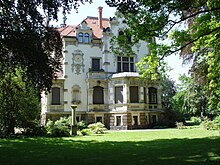Dresden villas
The extensive development of Dresden by villa colonies is called Dresden Villas . In addition to the closed development of the Dresden suburbs and the garden cities, these quarters form an architectural testimony to the Wilhelminian era and the Belle Époque , but are also being rebuilt to the present day. Blasewitz and Loschwitz / Weißer Hirsch are particularly well-known villa colonies in Dresden.
City districts and villa colonies

The structures of the villa districts in Dresden are quite different. Some of the villa colonies are adapted to the landscape, well structured or based on the historical village structures. The colonies are also partially cross-city districts.
The villa colonies stretch along the Dresden Elbe slopes in the northeastern districts of Radeberger Vorstadt (in particular the Prussian Quarter and Waldschlösschenviertel ), Weißer Hirsch , Bühlau , Loschwitz and Wachwitz along Bautzner Strasse / Bautzner Landstrasse in a kind of landscape park between Dresden Heide and Dresden Elbe Valley. At the center of this chain along the Elbe are the Elbe castles . The arrangement of the buildings and the course of the streets follow the natural conditions. Interrupted by districts in the north-west of Dresden, this type of hillside development continues in Radebeul in the local districts of Oberlößnitz and Niederlößnitz . Neighboring and east of the Lößnitz are the residential areas of Trachenberge, especially on the Wilder Mann . Also on the edge of the Dresden Heath, but away from the Elbe Valley, lies the residential district of Klotzsche (with Königswald ) in the north, which, like the White Deer, sought to become a health resort.
In the plain on the opposite southern bank of the Elbe there are chessboard-shaped districts such as Blasewitz , the eastern Johannstadt , Tolkewitz , Neugruna and Striesen . Further south, in the southern suburbs (especially in the diplomatic quarter and in the Bavarian quarter ), a well-planned and straight-line structure was laid out even at the beginning of the hillside. Niedersedlitz is similarly built up to the east and west of the village center on the Lockwitzbach and adjacent Leuben . The development of these quarters is less individual and castle-shaped, but was more based on city villas with the same basic dimensions , some of which were built as apartment buildings. The villa colonies form terraces on the slope around the Beutler Park in the eastern southern suburb. In Plauen , Blasewitz and also in the Südvorstadt, the central squares of the districts are built-up, for example on Schillerplatz . The villas are located around the Great Garden in the Strehlen , Gruna and Johannstadt districts . The Wasaplatz in chasing is an example of partially open buildings a central square. Along the Bürgerwiese , the villa districts stretched from the edge of the Great Garden to near the Dresden City Hall to the edge of the historic old town .
The villa districts of Laubegast , Kleinzschachwitz , Zschieren and Pillnitz are characterized by the village structures . Village cores are preserved in almost all villa colonies outside the suburban ring. Places like Wachwitz, Laubegast or Blasewitz emerged as fishing villages and ferry stations. Like the Radebeul districts at the foot of the Lößnitz , Pillnitz is also shaped by viticulture.
In addition, there are villas as individual monuments and in some cases with high architectural and historical importance even in prefabricated districts such as Prohlis . There are also smaller villa colonies in Lockwitz , Torna , Leubnitz-Neuostra , Mockritz and Coschütz in the south of Dresden along the slope there and in the side valleys .
Duration

The air raids on Dresden mainly hit the historic city center of Dresden. The former villa suburbs were outside the attack area. Only villa districts near the city center and on the edge of the suburban belt were hit by bombs. In some parts of the city, however, some outstanding villa structures have been lost. There were losses, for example, in Parkstrasse in the English Quarter ( Wettin House, which was formerly the most expensive private building in the city), in Bürgerwiese (broken off, formerly an avenue-shaped Renaissance transition from the Great Garden to the Altmarkt ), near Wiener Platz and along Wiener Strasse , in parts of the Südvorstadt , on Sachsenallee , Prager Straße , corner development of the Brühlsche Terrasse and south of the Postplatz .
Due to their expansion over the city area, a relatively large number of Dresden residents live in the villa colonies. With around 40,000 inhabitants (as of 2016), Striesen is Dresden's largest district. The district Blasewitz has just under 90,000 inhabitants (2017), the highest population density among the districts of Dresden . In many places, however, villas are also used as law firms, practices and offices. The preservation of the historical and listed buildings is facilitated by their commercial value as upscale real estate.
Formative architectural styles

While in other regions pompous buildings were often rejected as waste by the general population, the often reserved representative architecture in Dresden enjoyed popularity among all social classes and led to an identification with the city. Visual relationships, designed by leading architects of their time from the baroque to the industrial age, were often more important than individual power-demonstrating details.
The villa colonies emerged in the architectural epoch of historicism . This took form elements from bygone eras and used them, sometimes in an eclectic combination, on new buildings. The neo-baroque and neo-renaissance exerted a great influence , especially the Dresden variant of the neo-renaissance, the Semper-Nicolai school , which left behind many buildings that are still preserved today. The neo-Gothic style was based on French models and was less considered in the reconstruction than the Baroque and Renaissance . It only played a minor role in villa architecture ( White Castle on Königsheimplatz ), the most important building was the Johanneskirche , but the best known was the simply designed Sophienkirche . For a long time there were outside influences, for example in addition to the dominant sophisticated models also in Russian and English architecture. There are also elements of the Tudor style or the formal language of country houses and mansions as well as wineries on villas.
In addition to Schilling & Graebner , the Ziller brothers in particular left behind many villas that shape the cityscape . Later, houses with modern and postmodern architecture were added in isolated cases .
literature
- Fritz Löffler : The old Dresden - history of its buildings , Seemann-Henschel, ISBN 3-363-00007-3 .
- Volker Helas : Villa architecture in Dresden , Benedikt Taschen Verlag, ISBN 978-3-8228-6604-7 .
- Siegfried Thiele: 99 Dresden villas and their residents , HochlandVerlag Pappritz, ISBN 978-3-934047-58-7 .
Footnotes
- ↑ Statistical reports: District catalog 2016 (PDF; 28.6 MB) State capital Dresden, accessed on July 8, 2018 (sum of the population figures of the three statistical districts Striesen-Ost (15149), Striesen-Süd (11267) and Striesen-West ( 13223) for 2016).
- ^ Statistics of the Blasewitz district. State capital Dresden, accessed on July 8, 2018 .



